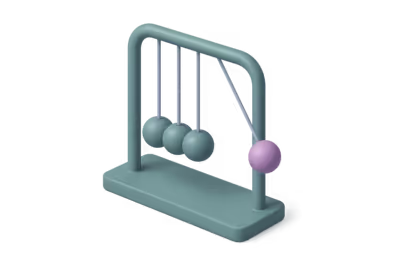Dynamics
Newton’s Laws
First Law of Newton (Inertia)
An object at rest remains at rest, and an object in motion continues in motion unless acted upon by a net force.
Second Law of Newton
where:
= net force = mass of the object = acceleration
Third Law of Newton
For every action, there is an equal and opposite reaction.
Forces
Weight (
where:
= acceleration due to gravity ( on Earth)
Normal Force
The force exerted by a surface to support the weight of an object in contact with it.
Frictional Force (
where:
= coefficient of friction = normal force
Work and Energy
Work
Work (
where:
= applied force = displacement = angle between the force and the displacement
Energy
Kinetic Energy (
Gravitational Potential Energy (
where:
= height above a reference level
Principle of Conservation of Energy
Total Energy
Rotation
Rotational Motion
Angular Position
Where:
= final angular position (in radians) = initial angular position = initial angular velocity (in rad/s) = angular acceleration (in rad/s²) = time
Angular Velocity
Where:
= final angular velocity
Relationship between Angular Velocity and Position
Moment of Inertia (
where:
= mass of each particle = distance from the axis of rotation
Torque (
Second Law of Newton for Rotation
Where:
= torque (in Newton-meter) = moment of inertia (in kg·m²) = angular acceleration (in rad/s²)
Moments of Inertia
Solid Cylinder
Solid Sphere
Thin Ring
Rotational Energy
Rotational Kinetic Energy
Work Done by Torque
Where:
= work done = torque = angular displacement (in radians)
Linear Kinematics
Uniform Rectilinear Motion (URM)
Position
Where:
= final position = initial position = constant velocity = time
Uniformly Accelerated Rectilinear Motion (UARM)
Position
Where:
= final position = initial position = initial velocity = constant acceleration = time
Velocity
Where:
= final velocity
Velocity Equation
Rotational Kinematics
Circular Motion
Tangential Velocity
Where:
= tangential velocity = radius of the circular path
Angular Velocity (
Relationship between Linear and Angular Velocity
where:
= radius of the circular path
Centripetal Acceleration (
Uniformly Accelerated Rotational Kinematics
Angular Position
Where:
= final angular position (in radians) = initial angular position = initial angular velocity (in rad/s) = constant angular acceleration (in rad/s²) = time
Angular Velocity
Where:
= final angular velocity
Relationship between Angular Velocity and Position
Oscillatory Motion
Simple Harmonic Motion (SHM)
Position Equation
where:
= amplitude = angular frequency = initial phase
Frequency (
Virtual Work Theorem
The Virtual Work Theorem (or Theorem of Virtual Work) states that for a system in equilibrium, the sum of the virtual works done by the active forces is equal to the sum of the virtual works done by the reactive forces.
Key Definitions
Virtual Work (
Where:
= virtual work done by a force = virtual displacement in the direction of the force
Conditions of Equilibrium
For a system to be in equilibrium, the following conditions must be met:
Sum of Forces in Equilibrium
Sum of Moments in Equilibrium
Applications of the Virtual Work Theorem
Total Virtual Work
This implies that the sum of the virtual works done by all active forces is equal to the sum of the virtual works done by the reactive forces.
Application in Particle Systems
In a particle system, the theorem is applied similarly by considering the work done by external forces on each particle.
Example Application
In a system with a body in equilibrium under the action of external forces

